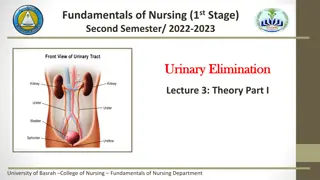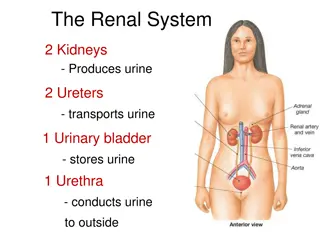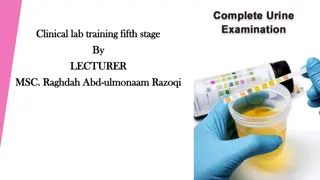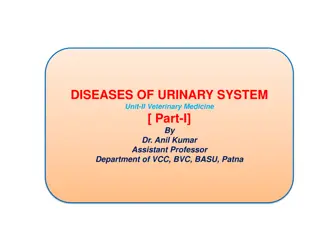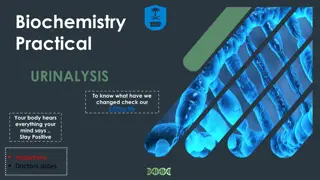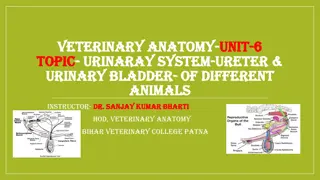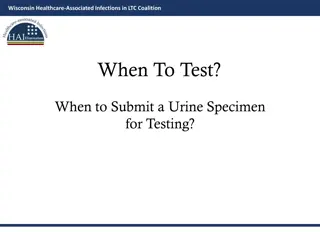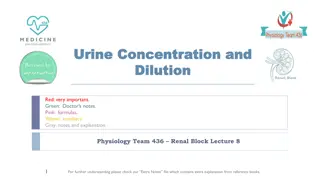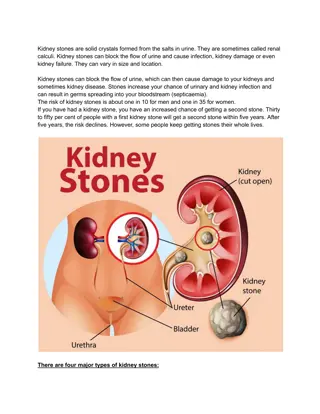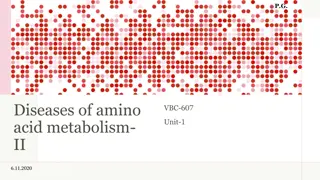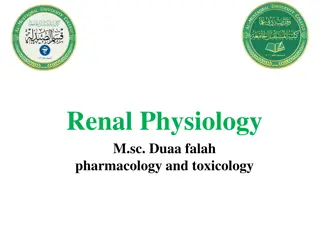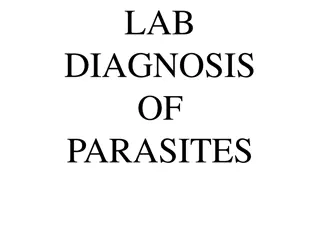Urinary Elimination: Anatomy, Physiology, and Function of the Kidneys
The lecture covers the fundamentals of urinary elimination focusing on the kidneys' location, structure, function, and the role of nephrons. It discusses the transport of urine through the ureters to the bladder, highlighting the bladder's muscle layers and the urethra's role in expelling urine. Stu
6 views • 37 slides
An Overview of the Renal System and Nephron Anatomy
The renal system consists of the kidneys, ureters, urinary bladder, and urethra, responsible for producing, transporting, storing, and excreting urine. The kidneys are surrounded by three layers, and the nephron is the functional unit responsible for filtering blood and producing urine. Key componen
5 views • 26 slides
Urinalysis: Importance and Interpretation
Urinalysis is a crucial diagnostic test used to detect various disorders like infections, kidney diseases, and diabetes by examining the physical, chemical, and microscopic properties of urine. It involves assessing color, specific gravity, and chemical content, such as pH and protein levels. The in
1 views • 22 slides
Urinary System Function in Veterinary Medicine
The urinary system in veterinary medicine involves the anatomy and physiological functions of maintaining body fluid composition and volume. Key processes like urine production, filtration, reabsorption, and regulation through nephrons play vital roles in maintaining overall health. This article cov
1 views • 14 slides
Urinalysis: Importance and Interpretation of Urine Analysis Parameters
Urinalysis is a crucial diagnostic tool that provides valuable insights into various health conditions through the examination of urine physical and chemical properties. This examination helps in detecting abnormalities such as diabetes, renal failure, dehydration, and infections. By understanding t
1 views • 11 slides
Veterinary Anatomy of Urinary System in Different Animals
The urinary system in animals includes kidneys, ureters, and the bladder, all crucial for filtration and urine excretion. The ureters are excretory ducts from the kidneys, while the bladder stores urine before expulsion. Various diagrammatic structures illustrate the urogenital system of animals, pa
0 views • 20 slides
Mechanisms for Concentrating & Diluting Urine in Maintaining ECF Osmolarity
Explore the intricate processes involved in concentrating and diluting urine to regulate extracellular fluid (ECF) osmolarity through mechanisms like the loop of Henle and vasa recta. Understand the factors influencing the ability to create a concentrated medullary gradient, differentiate water diur
0 views • 26 slides
Alcohol Absorption, Elimination, and Units: A Comprehensive Overview
Alcohol, specifically ethanol, is absorbed through the stomach and intestines into the bloodstream within minutes, and it is primarily eliminated through breath, sweat, urine, and the liver. The concept of a unit of alcohol helps in calculating safe consumption levels, with factors like volume and a
4 views • 16 slides
Software Testing Metrics and Tools
Software testing metrics play a crucial role in evaluating the quality and progress of the testing process. Metrics provide valuable insights into the readiness, quality, and completeness of a product. By measuring attributes such as defects, testing efficiency, and productivity, organizations can m
4 views • 100 slides
Fundamentals of Software Testing Explained
Software testing is a critical process to ensure that software applications meet requirements and are free of defects. It involves various activities such as test planning, analysis, design, implementation, and execution. Testing approaches like the Bing bang approach and Total Quality Management ar
1 views • 48 slides
**Wisconsin Healthcare-Associated Infections in LTC Coalition: Urine Testing Guidelines**
The Wisconsin Healthcare-Associated Infections in LTC Coalition provides guidelines on when to test and submit urine specimens for testing in long-term care facilities. The focus is on reducing unnecessary urine testing, introducing tools like the UTI Stoplight Tool and the When To Test-Nursing Tool
5 views • 16 slides
Equivalence Class Testing and Its Application in Software Testing
Equivalence class testing is a software testing technique that involves dividing input values into classes for effective testing coverage. Equivalence classes are defined mathematically as subsets of a given set, ensuring partitioning and mutual exclusivity. By applying equivalence partitioning, tes
3 views • 21 slides
General Urine Examination and Stool Examination
General urine examination involves analyzing the color, clarity, and chemical composition of urine, providing insights into various health conditions and potential issues. It helps in detecting metabolic disorders, kidney diseases, and drug abuse. Additionally, the general stool examination is essen
0 views • 37 slides
Uganda's Successes in Reaching Men with HIV Testing Through Assisted Partner Notification Program
Uganda has successfully implemented an Assisted Partner Notification (APN) program to reach men for HIV testing, addressing the gender gap in testing rates. By utilizing various approaches such as index testing, self-testing, and social network testing, Uganda has achieved significant success in tar
0 views • 12 slides
Nephritis: Causes, Symptoms, and Subtypes
Nephritis is a serious medical condition characterized by inflammation of the nephrons in the kidneys. This inflammation can lead to various subtypes such as glomerulonephritis and interstitial nephritis, each with its own causes and symptoms. Common symptoms of nephritis include edema, changes in u
0 views • 26 slides
Analysis of Urine Composition in Volunteers Under Various Conditions
This study involved measuring the volume and composition of urine from four groups of volunteers under different conditions: control, water intake, saline intake, and Lasix administration. The data recorded included urine volume, osmolality, pH, Na+ concentration, flow rate, and Na+ excretion rate,
0 views • 18 slides
Software Testing Foundation Level: Testing Throughout the SDLC Quiz
Explore key concepts in software testing throughout the Software Development Lifecycle (SDLC) with a quiz covering topics like white-box testing in acceptance testing, component testing vs. system testing, and regression testing purposes. Enhance your understanding of testing methodologies with samp
5 views • 17 slides
Importance of Software Testing in Preventing Catastrophic Failures
Software testing is crucial in ensuring the reliability and safety of software systems, as highlighted by catastrophic failures such as the Ariane 5 rocket incident and the Therac-25 radiation therapy machine disasters. These examples underscore the importance of thorough testing in identifying and
1 views • 42 slides
Common Laboratory Techniques in Zoology - Urine and Stool Specimen Analysis
In the Biology Department at Al-Mustansiriyah University, students learn laboratory techniques for collecting and analyzing urine and stool specimens. The process involves random urine sample collection, urine tests for chemical components, urine culture, stool specimen analysis for pathological con
0 views • 10 slides
Testing Approach in SCREAM for E3SM Fall All-Hands 2019
Major effort is focused on verification and testing in SCREAM for the E3SM Fall All-Hands. The initiative includes unit testing, property testing, regression testing, and leveraging various tools like Cmake, Python, Jenkins, AutoTester, and GitHub for Continuous Integration (CI). The emphasis is on
1 views • 21 slides
Reflex Urine Culturing in UTI Diagnosis: Dos and Don'ts
Reflex urine culturing is a crucial diagnostic strategy for UTIs in hospitalized patients, emphasizing the importance of suspicion over urinalysis. Misuse can lead to increased positive cultures. Understanding the relevance to SPARC and focusing on diagnostic stewardship can help prevent unnecessary
0 views • 21 slides
Urine Concentration Mechanisms in the Renal System
The lecture covers the concepts of urine concentration and dilution in the renal system, focusing on the loop of Henle and countercurrent multiplier and exchange systems. It discusses how the loop of Henle reabsorbs salt and water to determine urine osmolarity, factors influencing medullary gradient
0 views • 20 slides
Kidney Stone Treatment in Pune with Dr Abhijit Gokhale
Kidney stones are solid crystals formed from the salts in urine. They are sometimes called renal calculi. Kidney stones can block the flow of urine and cause infection, kidney damage or even kidney failure. They can vary in size and location.\n
0 views • 4 slides
Maple Syrup Urine Disease and Albinism
Maple Syrup Urine Disease (MSUD) is a metabolic disorder affecting the breakdown of branched-chain amino acids, leading to severe symptoms like physical and mental retardation, sweet-smelling urine, and metabolic acidosis. Treatment involves dietary restrictions and potential gene therapy. Albinism,
0 views • 16 slides
Testing in Software Engineering
In the previous session, we discussed various aspects of software engineering, including modeling with UML diagrams, such as activity diagrams, use case diagrams, sequence diagrams, state diagrams, and class diagrams, as well as architecture patterns. Testing was emphasized as a key aspect, highligh
0 views • 35 slides
Gray Box Testing in Software Development
Gray Box Testing is a software testing technique that involves testing the software with partial knowledge of its internal workings. It combines aspects of White Box Testing and Black Box Testing, allowing testers to check both the presentation layer and the code part of an application. Gray Box Tes
0 views • 14 slides
Efficiently Managing Urine-Diverting Dry Toilets (UDDT) Systems
This detailed guide explores the principles and practices of using Urine-Diverting Dry Toilets (UDDT), focusing on their construction, usage, and maintenance. Learn about the benefits, challenges, common mistakes to avoid, and essential tips for optimizing UDDT performance. From understanding the ty
0 views • 20 slides
Diabetes Insipidus: Types, Causes, and Symptoms
Diabetes insipidus (DI) is a disorder caused by a deficiency of anti-diuretic hormone (ADH), leading to the excessive passage of diluted urine. Central DI results from pituitary or hypothalamus issues, while nephrogenic DI occurs when the kidneys fail to respond to ADH. Common causes include brain t
0 views • 22 slides
Analytical Toxicology: Techniques and Sample Analysis in Clinical Toxicology
Analytical toxicology involves the observation, identification, and measurement of foreign compounds in biological and other samples, such as urine, blood, stomach contents, nails, hair, and DNA. Various techniques are used to isolate and identify drugs and poisons present in these samples. This fie
0 views • 12 slides
Utilizing Different Samples for Diagnostic Testing in Medicine
The practice of diagnostic testing in medicine goes beyond blood and stool samples. Gathering urine samples, for example, allows healthcare providers to assess various health aspects, such as kidney function, urinary tract infections, diabetes, and more. By examining the color, clarity, odor, densit
0 views • 21 slides
Requirements-Based Testing in Software Development
Dive into the world of requirements-based testing in software development, exploring main concepts, test levels, testing roles, and the importance of testing your solution and modeling case. Learn about test cases, different testing activities, and the significance of acceptance testing in identifyi
0 views • 16 slides
Guidelines for HIV Testing During Pregnancy and Postpartum
These guidelines recommend HIV testing during pregnancy, at delivery, and postpartum. Testing should be done early in pregnancy and again in the third trimester. Expedited testing during labor is required for certain patients, and syphilis testing is recommended. Pre-exposure and post-exposure proph
0 views • 18 slides
Comprehensive Overview of Fault Modeling and Fault Simulation in VLSI
Explore the intricacies of fault modeling and fault simulation in VLSI design, covering topics such as testing philosophy, role of testing in VLSI, technology trends affecting testing, fault types, fault equivalence, dominance, collapsing, and simulation methods. Understand the importance of testing
0 views • 59 slides
Unit Testing in Software Engineering
Concept Software is a discipline comprising various code pieces. Testing these codes together is complex but vital in Software Engineering. The process includes early testing like unit tests, pairwise/multiple component testing, module testing, integration testing, user tests, alpha tests, beta test
1 views • 6 slides
Renal Physiology and Functions
This content covers the aims of studying renal physiology, functions of the kidney, basic renal processes, renal secretion, urine formation, and types of renal failure. It delves into topics such as water balance, electrolyte balance, urine production, and the components of the urinary system. The i
0 views • 10 slides
Integration Testing and Levels of Testing
Explore the importance of integration testing in software development, covering topics such as traditional testing levels, the SATM system, goals and purposes of integration testing, testing level assumptions and objectives, software process overview, various approaches to integration testing, and t
0 views • 39 slides
General Urine Examination
General Urine Examination involves analyzing waste products, collection of urine specimens, factors affecting urine amount, preservation methods, physical examination characteristics like color and transparency, specific gravity, odor, and chemical properties including pH, protein, glucose levels. I
0 views • 13 slides
Importance of Software and System Testing
Understanding the critical role of software and system testing in identifying and fixing errors before they lead to major failures. Various types of testing such as functional, usability, performance, and reliability testing are essential to ensure the quality of software products. Different classif
0 views • 52 slides
Laboratory Diagnosis of Parasites: Methods and Clinical Specimens
Laboratory diagnosis of parasitic infections involves techniques such as demonstration of parasites, immunodiagnosis, and molecular biological methods. Clinical specimens for diagnosis include blood, urine, genital specimens, sputum, and tissue biopsy/aspiration. Chyluria, a condition with milky whi
0 views • 24 slides
Global Urine Bags Market Size, Share, Analysis, Growth, Trend, Forecast to 2030.
The Global Urine Bags Market Size is expected to reach USD 1820 million by 2030, at a CAGR of 4.7% during the forecast period 2022 to 2030.
0 views • 4 slides
